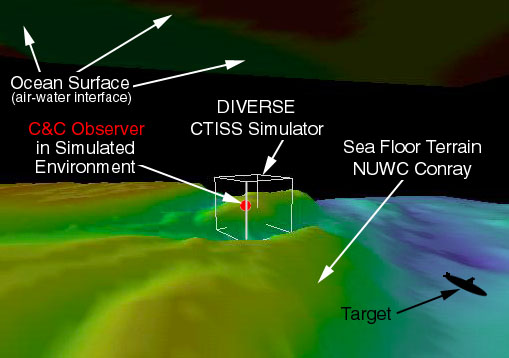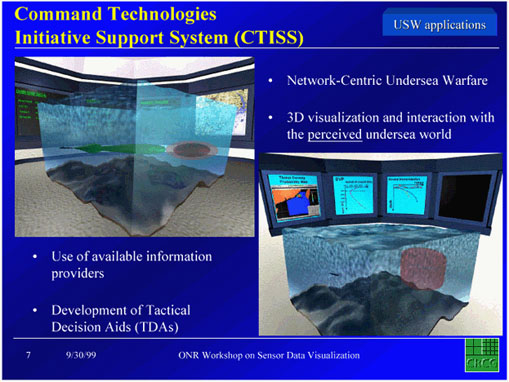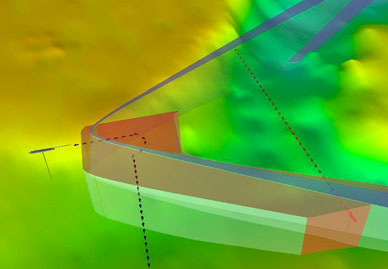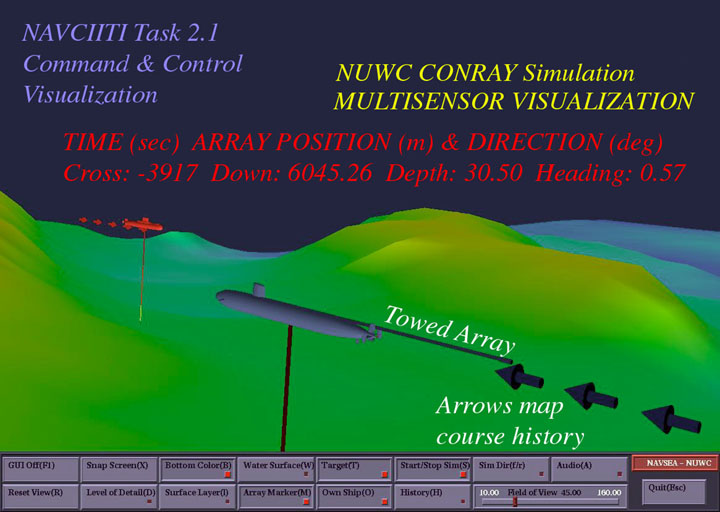Navy Collaborative Integrated Information Technology Initiative (NAVCIITI)
of the Advanced Communications and Information Technology (ACITC)
--
Naval Undersea Warfare Center Collaboration
NAVCIITI Task 2.1: Command and Control Visualizaiton
(http://www.sv.vt.edu/future/cave/resprj/navciiti/nuwc_task2-1/nuwc_task2-1.html)
Office of Naval Research
Ken Reifsnider, Principle Investigator
Ron Kriz, CoPI
Command and Control Visualization, Task 2.1
November 17, 2000
Virginia Tech
Blacksburg, VA
Background: Our objective is to provide a distributed collaborative network of
graphical and device independent tools in a shared virtual environment which can be
used by Command and Control (C&C) personnel to gain a strategic advantage.
Specifically we focus on the mission critical C&C interpretation of acoustic undersea
data from towed arrays for the Naval Undersea Warfare Center (NUWC) using the CONRAY
simulation models. These simulation models can be extended to "real-time" data
acquisition systems. Under the direction of personnel from NUWC and the Naval Research
Laboratory (NRL) we have identified a working prototype which we have successfully
incorporated into our Device Independent Virtual Environment
Reconfigurable-Scalable-Extensible (
DIVERSE) tool that works in stereo in the (C)AVE
Automated Virtual Environment (CAVE), Immersive Work Bench (IWB), Immersive Desk
(I-Desk), desktop workstation simulator, and Head Mounted Display (HMD) systems at the
Virginia Tech Center for Virtual Environments and Visualization (CVEV), hence the idea
of "DIVE" (Device Independent Virtual Environment). The DIVE in DIVERSE provides the
basis for collaborative C&C.
Discoveries, Accomplishments, Test Results: Our team has taken the existing
CONRAY simulation model from NUWC and put it in stereo on the IWB using DIVERSE as
requested. It has not been determined at this point if DIVERSE will be the graphical
interface used in the prototype. DIVERSE was used to demonstrate and evaluate the
NUWC-CONRAY model in a stereo immersive environment. As a result of this current
accomplishment the CONRAY model has been upgraded from Performer 1.3 to Performer 2.2
which allows for extensibility for future development. A snapshot of the DIVERSE
Simulator running in the CONRAY model is shown in Figure 1 which shows the C&C observer
below the ocean surface and immersed in the ocean terrain overlooking a target. From
the observers point of view the DIVERSE Simulator can incorporate a CTISS interface as
shown in Figure 2. The DIVERSE Simulator can also incorporate the collaborative
awareness tools (2D-, 3D-radars, participant lists, teleportation, etc.) from the
CAVE Collaborative Console (
CCC) so that these or
other collaborative graphical tools or devices can be included as relevant C&C features.
The CONRAY Simulation Model, shown in Fig. 3, is viewed by the C&C observer, shown if
Fig. 1, in the three-dimensional volume region as illustrated in Fig. 2.
Activities during quarter: On August 15, 2000 R.D. Kriz visited NUWC at Newport,
Rhode Island where the CONRAY simulation was demonstrated on a small IWB followed by
discussion on how NUWC wanted to proceed. NUWC decided that they wanted to see the
CONRAY simulation working in stereo on an IWB at Virginia Tech on November 13 and 14,
2000. We have successfully accomplished this task and the results of this meeting will
be posted on the next NAVCIITI report to ONR.

Figure 1. Snapshot of the CONRAY Simulator running with DIVERSE
(NOTE: stereo can not be shown)

Figure 2. Command Technologies Initiative Support System (CTISS),
Ref: "ONR Workshop on Sensor Data Visualization", September 1999.

Figure 3. Tactical Command Space for the NUWC CONRAY Simulation Model
( View LARGE Simulation Image ) also
( View Animation of CONRAY Simulation )
Plans for Next Quarter: Now that we have a very basic working prototype we will
proceed with instructions from Dr. Larry Rosenblum at NRL and NUWC personnel on how and
what to incorporate into this prototype to enhance this prototype for C&C. There will
be a visit of key personnel from NRL and NUWC to observe this prototype on November 13
and 14, 2000. From this visit and discussions following we will proceed with decisions
from NRL and NUWC. Our next SOW due April 2001 will be to demonstrate these displays in
the working prototype.
Outstanding Issues: We anticipate that the results of the meeting with NUWC and
NRL on November 13 and 14, 2000 will require decisions from NRL and NUWC before we
proceed along any particular direction with this basic C&C prototype. We request that
NRL and NUWC provide:
- Task Analysis: Concrete definition of the task C&C
personnel will perform in context of use.
- User Interface: Definition and testing, based on task
analysis. Immersive displays are intrinsically more complex to handle due to extra
degrees of freedom.
Effective precise navigation, selection of objects and point of view are central to a
well designed user interface.
A visual summary of key elements of the current CONRAY simulation model is shown below
in Figure 4.

Figure 4. Key elements of the current CONRAY simulation model.
Please send your comments and questions to Ron Kriz at:
rkriz@vt.edu
Last Revision November 5, 2000
http://www.sv.vt.edu/future/cave/resprj/nuwc_task2-1/nuwc_task2-1_12feb01.html



